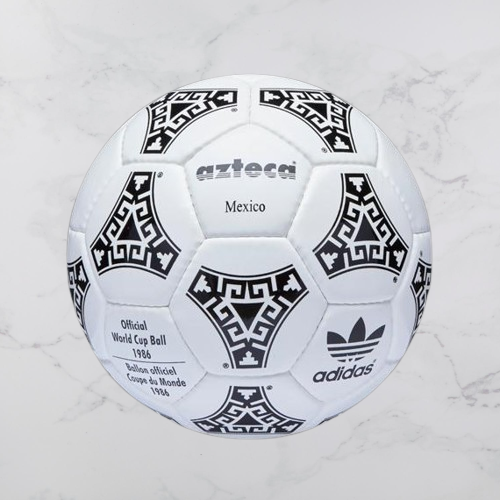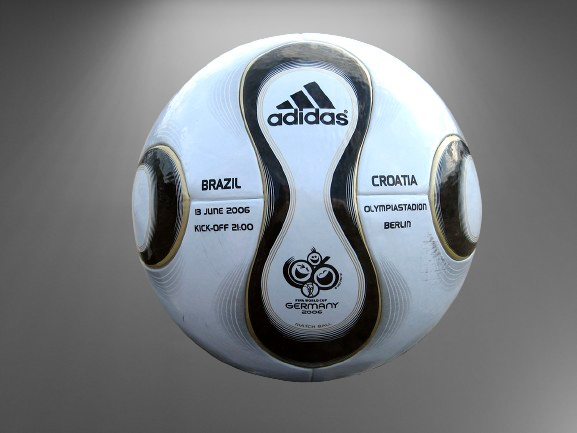Could the 90’s kids have imagined a soccer ball can have camera into it? The answer is no. But in 2022 FIFA World Cup the world saw it. The FIFA World Cup is one of the most anticipated events in the soccer world that takes place every four years. Fans always look forward to finding details like the venue, qualifiers, and team kits, mostly the soccer ball. Choosing the top five soccer balls in the history of the FIFA World Cup is subjective and may vary depending on personal opinions. However, based on their impact, design, and significance, here are five iconic soccer balls used in the FIFA World Cup:

Telstar soccer ball (1970): If someone really want to explore soccer ball’s history Telstar soccer ball would be at the top of the list. The Telstar was the official ball of the 1970 FIFA World Cup held in Mexico. It was the first ball to feature the iconic black and white pattern, which made it easily visible on black and white television screens. Its design revolutionized soccer ball visibility during matches. In addition to it even if in the current time it is the universal design of soccer ball which is used town to village and got a universal acceptance till its introduction to the world.

Azteca soccer ball (1986): The Azteca soccer ball was used in the 1986 FIFA World Cup held in Mexico. Azteca soccer ball is the first ball which has been made of fully synthetic material. Triad used in the design of the ball, where were painted like Aztecs frescoes. The Adidas Azteca soccer ball was quite an elegant ball with revolutionary design but even though it was still composed by 32 hand sewn panels. Its design was similar to the Tango but featured improved water resistance and performance. The Azteca soccer ball was notable for the “El Rollo,” which refers to the wavy pattern around the ball.

Teamgeist soccer ball (2006): The Teamgeist was the official soccer ball for the 2006 FIFA World Cup held in Germany. Word teamgeist stand for willingness of each member of a team or group to work together with loyalty and enthusiasm. Its design featured 14 panels seamlessly bonded together, offering improved aerodynamics and accuracy. The Teamgeist received praise for its performance and innovative design. These 14 external panels, that’s fetch to descreasing of joints on 60%. It’s aims to improve accuracy of stroke and improve ball control. The design has undergone significant changes compared with its predecessor. Although, this soccer ball is remembered for the famous French soccer player Zinedine Zidane’s foul in the final match and supporters still believe that if the foul did not happened and if the red card was not given to Zinedine Zidane France would have won the FIFA World cup 2006.

Jabulani soccer ball 2010: Jabulani soccer ball was the official match soccer ball for the 2010 FIFA World Cup. This ball is made from eight spherically moulded panels and has a textured surface intended to improve aerodynamics. It was consequently developed into the Adidas Tango 12 series of footballs. Jabulani, meaning “be happy!” in Zulu, is the imperative plural form of the verb jabula “to be happy”. Its design was much maligned by players at the World Cup, and production ceased after two years. In discussing the mechanics of the balls Rabi Mehta, an aerospace engineer at NASA Ames, described the unpredictable behavior as “a knuckle-ball effect”. They explained that when a seamed ball is struck with little spin it experiences asymmetrical air flow effects as a result of the air close to the surface being affected by those seams. This causes unpredictable movement akin to the intentionally pitched Knuckleball in baseball. Although, this soccer ball had some flows the whole world will remember this soccer ball, because this world cup was a tribute to Nelson Mandela (Madiba). In addition to it, the famous pop singer Shakira’s “Waka Waka” and “Give me Freedom” song relates to 2010’s FIFA world cup. These things make this soccer ball to be placed in the history of soccer world cup. Lastly, this FIFA world cup gave the world a new World Cup soccer champion and it was Spain.

Al Rihla Soccer ball (2022): In FIFA World Cup 2022 the used ball’s name, Al Rihla, means ‘the journey’ or ‘the excursion’ in Arabic. The Al Rihla is said to travel faster in flight than any other one in the tournament’s history to sustain high speed and quality competition. The name could also be interpreted as the journey’s travelogue, referring to the host nation’s journey to becoming the first Arabic nation to host the World Cup amid controversy and corruption allegations. Adidas used a 20-panel design inspired by Qatar’s architecture, art and national flag. It has modern multi-colored etches on a white base. The panels are triangular, reminiscent of the sails on dhow boats that are popular in the Gulf state. Contrary to popular belief, the color scheme is not of the night Doha skyline but of the Qatari flag and the white Arabic clothes. The manufacturers accounted for environmental factors during the games because the tournament will be held in one of the hottest and windiest places globally. They came up with the speed-shell innovation, a polyurethane leather surface with pitted panels bonded thermally to make it seamless. The design improves the aerodynamic speed of shots by maintaining stability and rotation in the air. The soccer ball was designed per sustainability and eco-friendliness standards, making it the first ever with water-based glues and inks. Designers included a semi-automated offside technology to improve the speed and accuracy of match decisions. The technology was successfully tested at the 2021 FIFA Arab Cup and will see video match officials receive offside alerts, verifying determinations manually before communicating to the on-field referee. The match soccer ball weighs 450 grams or 16 oz to make it light in the air and improve speed. It had a circumference of 70cm or 28 inches, with a pressure of 1.1 atmospheres or 1100g/cm2 or 15.6 lbs/sq in. Whatever, this soccer ball will carry a great significance to the Argentinian and Lionel Messi Fans as after three decades Argentina as well as Messi lift the trophy of the most prestigious soccer game’s tournament The FIFA World Cup 2022.
These soccer balls not only represent technological advancements in soccer ball design but also evoke nostalgia for the moments and matches they were associated with during the FIFA World Cup tournaments.


